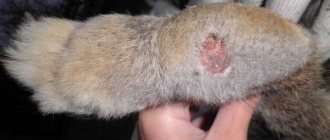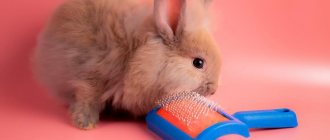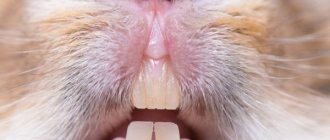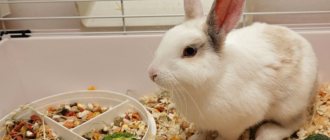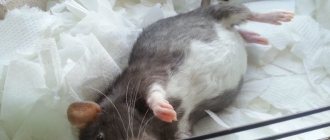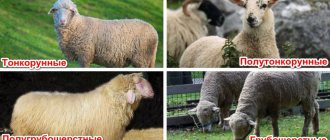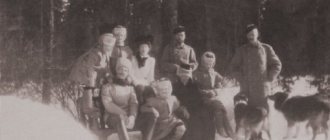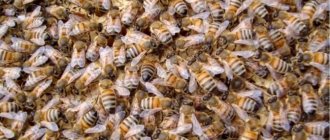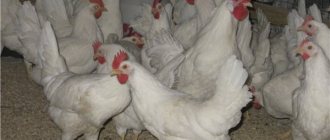Nail trimming is an essential part of caring for your pet rabbit. Some breeders, due to inexperience, believe that trimming is unnecessary or may harm the animal. But this opinion is wrong, because such a procedure, on the contrary, prevents uncontrolled growth and possible problems with the movement of the animal. Haircuts can be carried out at grooming centers or veterinary centers. But if you know some of the nuances, you can even trim your rabbit’s claws at home yourself, and at the same time save money on salon procedures.
How to carry out the procedure?
How to trim a rabbit's claws - we'll talk about this a little lower.
First, let's figure out why such a procedure is required at all. In the wild, claws help rabbits move properly. When the animal moves, they cling to the soil, thereby providing additional stability. Also, with their help in nature, rabbits dig holes. When walking and digging, rabbits' claws gradually wear down. Another thing is tame decorative animals. At home, rabbit claws in most cases quickly become a burden. After all, there is simply nothing for the animal to grind them off in the apartment. Therefore, after removing the sharp part, domestic rabbits usually feel much more comfortable. The answer to the question of whether rabbits' claws are trimmed can be given exclusively in the affirmative.
The main reasons for the need for this procedure in such animals when kept in an apartment are usually:
- Inability to accurately distribute weight when moving. The main emphasis in rabbits with untrimmed claws is on the heel. As a result, this part of the animal’s paws begins to suffer from wounds and calluses. In addition, because of this, rabbits' toes are often deformed.
- The likelihood that an animal will catch its claw on an object and get injured. Rabbits' feet are very delicate. And with a strong jerk, bones can even break.
- The possibility of a rabbit inflicting wounds on itself or its owner. To defend themselves, rabbits actively use their hind legs. In fear, they can inflict severe wounds on their relatives or even people.
Nail trimming begins at 3 months of age
It is important to take special care when grooming for the first time so as not to frighten or hurt your pet. Gradually he will get used to the procedure and will react calmly
Tool selection
If the nails are being cut for the first time and are still soft, then you can use nail scissors, which are usually used to cut nails. But later the claws become harder and you cannot use scissors for manicure, since they will not cut the claw right away, but will only crumble the nail plate and form cracks. This will cause trouble for your pet later.
To trim claws, you need to prepare special tools. These can be pedicure clippers with a wide slot or nail clippers. There are two types of nail clippers:
- in the form of a guillotine;
- special cutters with a limiter.
The blades of the devices must be made of steel, well sharpened and fit tightly to each other. Scissors should have rubber handles to prevent them from slipping out of your hands.
Before the procedure, all instruments should be disinfected. Then you need to choose the position in which the pet will be. If the rabbit is calm and allows itself to be placed on its back, then it is more convenient to carry out the procedure in this position. Having placed the animal on the table or on your feet, you need to fix the body with your left hand and with the same hand take the paw for processing. In this case, the rabbit's head should be under the elbow. For better access to the claw, lightly press the pad. You need to trim claws in a calm environment, without getting nervous, so as not to scare the animal. A special tool is used to cut off the dead part parallel to the foot.
It is important at this moment not to catch the soft tissue - the pulp, which contains the blood vessel and nerve ending. Before cutting, you need to carefully inspect the claw
You need to leave 3 mm to the pulp - this is the optimal length. If the claw is too short, it will be painful for your pet to step on its paw. The video clearly shows what length to leave. If it was not possible to place the rabbit on its back, you can ask an assistant to hold it, securely fixing its paws.
If you don’t have an assistant, you can use a diaper and wrap the eared one in it. By freeing each paw in turn, you can safely trim the claws. In this case, the rabbit will not be able to injure either itself or its owner. Nails should be trimmed in one procedure. In total, 18 claws will need to be trimmed.
Sorry, there are no surveys available at this time.
Of course, it is not very pleasant for the animal, but it is one of the important ones. Claws grow back quite quickly, and in the wild animals cope with this problem on their own. The nail plate wears down naturally with movement and physical activity. As for domestic decorative rabbits, they move quite a bit.
Required Tools
Little rabbits have rather soft claws. To cut them, nail scissors or pedicure clippers are usually used. Adult pets will need a special tool - a nail clipper. It is sold at any pet store or pet salon and is intended for cats or dogs. The tool looks like a guillotine cutter or scissors.
Important! Ordinary scissors are not used on adult animals. They make my nails very crumbly.
There are models with or without a special limiter. The first option is preferable, especially for beginners. It allows you to choose the appropriate length of the nail without catching small vessels. The nail clipper should be made of steel, with well-sharpened blades and rubber lining on the handles.
How to properly trim the claws of a decorative rabbit: step-by-step instructions
Recently, interest in decorative rabbits has increased. Some people get them, thinking that keeping a rabbit at home is much easier than keeping a dog or, say, a cat.
But this is far from true; you will need to learn how to properly care for a furry animal.
That is why it is worth asking how to trim a rabbit’s claws, because they grow quickly, are quite sharp and can injure the hands of your family members, especially children.
The need for the procedure
Trimming nails is not the most pleasant, but one of the important hygienic procedures for caring for a furry pet. Rabbit claws grow quite rapidly. They do not cause problems for wild eared animals living in natural conditions, since they wear off naturally when they move on rocky soil.
For a domestic decorative rabbit, for whom walking means jumping on the grass, and moving around the house means sliding on laminate or linoleum, it is necessary to trim its claws, since they do not grind down naturally.
There are a number of other reasons for the need for this procedure:
- The rabbit can get hurt by its long claws when it starts to itch.
- Due to overgrown claws, the long-eared animal cannot rest on the sole of its hind paws, and all the weight falls on the heels, causing calluses to appear on them.
- When the claws grow excessively, they curl and bend, this causes discomfort to the animal and it begins to gnaw on them.
- And finally, because of them, the animal can be injured (break a finger) if it gets caught on the carpet.
Preparing the animal
The furry baby should be accustomed to the unusual procedure gradually as soon as he adapts to his new home.
Since it’s easier to trim a baby rabbit’s claws when he’s lying on his back, each time you pet him, place him on your lap, holding him under his front paws with one hand and fingering his fingers with the other.
Gradually, he will get used to such treatment and will be less afraid and resist, thereby simplifying the procedure.
If you have never had to trim an animal’s claws before, then during the first procedure, ask someone to hold your big-eared fidget.
If there is no one to help, try to calm the animal down a little, otherwise at the most crucial moment it may panic and begin to break free.
To prevent such a situation, limit the mobility of the eared one, for example, wrap it in a towel, leaving only the head free. After this, release one paw at a time, trim the nails and put it back under the towel before removing the next one.
Step-by-step instructions for the procedure
- It is more convenient to start cutting from the front paws. To gain greater access to the claw, press on the pad and move the fur away. This will allow you to examine each claw in bright light to determine where the pulp begins - living tissue with blood vessels and nerve endings. Usually it is located closer to the base. If the animal's claws are transparent, its red capillaries are clearly visible, but they can be seen even through the dark stratum corneum.
- Using a claw cutter, only the dead tip of the claw is cut off, and it is better to remove it little by little in several steps so as not to accidentally touch the pulp.
- After clipping, inspect the claw again for any sharp parts. If there are any, you need to remove them with scissors or a coarse nail file.
- The claws of the vestigial toes on the front paws should also be trimmed.
- After treating one paw, it is advisable to take a break. This will be useful for a rabbit wrapped in a towel. You should let it rest by unwrapping it for 5 minutes to prevent it from overheating. At the same time, hold the rabbit in your arms until he calms down, reward him with his favorite treat.
What to do if a capillary is damaged
Sometimes even experienced people make mistakes, touching the pulp, as a result of which blood begins to flow. In such a case, there is no need to panic, but after postponing the haircut, start stopping the bleeding.
To do this, you should have a hemostatic pencil or the usual hydrogen peroxide on hand. If you can't stop the bleeding, take your cat to the vet.
After treating the wound, stop walking around the house and outside for a while.
If this procedure is carried out regularly, then gradually it will cease to be painful for the animal and troublesome for its owner, and it will also help to avoid serious illnesses. Don’t forget that regular nail care is one of the conditions for a decorative rabbit’s vigorous appearance and mobility, and they are known to be the main signs of an animal’s health.
Fixation
There are several ways to restrain a rabbit before trimming its claws. We will look at the best of them now.
- Fixation in a supine position. But this method will only be effective if the animal is accustomed to this position from a young age. In other cases, the animal usually breaks out.
- Fixation in a sitting position on a table. To do this, you need to place the eared one on the edge of the table, to your left. With your elbow, carefully grasp it and lean it against you. The slight tightness reminds him of being in a hole, so he usually calms down quickly. In this position, it is convenient to trim with your right hand, supporting the paw with your left.
- Fixation in a towel. To do this, you must wrap the rabbit like a small child. Leaving only the head outside. Carefully pulling out one paw at a time, trim the claws. Just remember, before pulling out each next leg, the previous one must be hidden back.
- Unfamiliar room. Oddly enough, in an unfamiliar room the animal will behave much calmer. Which makes the task much easier.
It would be best if one more person could help in this matter. Together it is much easier and easier to handle a pet. And it will be less stressful for him.
How to trim the claws of a decorative rabbit
The claws grow very rapidly. The paws of the decorative rabbit have sharp claws. He got them from wild relatives. Under natural conditions, claws help the animal move along the ground and build its burrows or nests.
If a rabbit is in danger, it jumps up and kicks the offender with strong hind legs with extended claws. When moving on the ground, the claws wear down naturally. If a decorative rabbit sits in a cage most of its life, then its claws grow without stopping.
Is it possible to trim claws and why should it be done?
Trimming the nails of decorative rabbits, which spend most of their lives in a cage, is not only possible, but also necessary. This procedure is necessary for the following reasons: The pet can injure its owner.
- claws that are too long cling to various obstacles when the animal moves, it can simply tear them out with part of the pad;
- untrimmed claws prevent the rabbit from walking normally, abrasions, calluses, and dermatitis form on the heels;
- If not trimmed in time, the claws cause deformation of the fingers; in advanced cases, the fingers remain disfigured for life.
Rabbits are shy animals with strong hind legs. In a moment of fright, they can seriously injure the owner or his child.
This is one of the main reasons for timely shortening of claws.
How to properly pick up an animal.
To trim claws you need to have:
- nail scissors;
- cutters with a limiter;
- nail clipper - guillotine.
A young rabbit aged 10-12 weeks undergoes the procedure for the first time. The claws are still soft and can be easily removed with ordinary manicure scissors.
In the future, in order to trim your pet’s nails, you will need to purchase a tool at a pet store. Here the choice of model remains with the owner. It depends on skill and experience. In addition to the tool, you will need:
A nail clipper can be purchased at any pet store.
- alcohol;
- cotton swabs;
- peroxide;
- streptocide powder;
- hemostatic sponge;
- lamp or flashlight;
- a blanket or thick blanket;
- table.
It is advisable to have an assistant present.
Read how to find out the gender of a dwarf rabbit.
Step-by-step instructions on how to trim your nails correctly:
- lay out tools and materials on the table;
- disinfect the instrument with alcohol using a cotton swab;
- fix the animal by turning it on its back, placing its head on the elbow, and fix the limb with your fingers; you may have to wrap the animal in a blanket;
- turn on the table lamp and direct its light to the paw being treated; if there is an assistant, he can illuminate it with a flashlight;
- Use wire cutters or a nail clipper to shorten each claw.
The claw should not be trimmed close to the finger. It is necessary to leave a safe gap of at least 3-5 mm.
If it happens that awkward manipulation causes damage to the pulp and blood vessels, then the damaged area is treated with hydrogen peroxide and sprinkled with streptocide. In case of severe bleeding, use a hemostatic sponge to stop the bleeding.
How to train a rabbit?
Nail care
After the procedure, pamper your pet with a treat. In order for the pet to get used to the not very pleasant procedure, it must be accustomed to it from the first days of living in the house. As soon as the animal adapts to the new conditions, this will take 5-6 days, it is picked up.
Place him on his back and examine his paws and claws. This is done even when the claws have not yet grown. At first, the animal is held for no longer than 30 - 40 seconds, gradually increasing the time to 3-5 minutes. After the manipulations, the pet is given a piece of carrot or other treat.
Thus, by the time the animal is 3-4 months old and the time comes to shorten its claws, it will be calm about such actions.
The frequency of the procedure depends on several factors and is individual for each pet. The need for it occurs once every 6 - 8 weeks.
If an adult animal with very neglected claws comes into your home, it is better to contact a veterinary clinic.
During manipulations, you should not put too much pressure on your pet’s back, as this is the most vulnerable spot. If the animal is struggling strongly, then it needs to be held by its sides with both hands.
There is nothing complicated in the procedure for trimming the claws of a decorative rabbit. Every owner can master it. If the animal is walked outdoors a lot, the claws wear down on their own. In this case, human intervention will be required much less often.
Possible errors and complications
Errors and complications during the dog nail trimming procedure are not that rare. They are often associated with the behavioral characteristics of animals and with the individual characteristics of the color and anatomical structure of the claws
In this context, it is important to consider a number of aspects
- If your animal's nails are dark in color (black claws), which makes nail trimming difficult, you should consult a veterinarian. But it is better to visit him and watch his work, as an example for future independent work.
- If the dog twitches sharply and does not allow the procedure to be carried out, then it should be wrapped in a diaper (for small animals). Two people are involved in the procedure - one fixes the dog in his lap, the other frees the paw and begins the haircut.
- If the pet is struggling and whining, but the nail bed is clearly not affected, then the dog most likely has a high level of sensitivity. You can purchase a solution of lidocaine, which you can use to treat your dog’s paw a few minutes before trimming the nails.
- It is useful to record the dates of haircuts in a special dog care calendar. This will simplify the process of monitoring procedures.
- If the existing tool is not able to cope with the thickness of the claw, then you should try to remove the claw with a nail file.
Open wounds in dogs resulting from procedures should be carefully avoided. If one does appear and begins to bleed, you cannot allow the pet to hide in a dark corner and self-medicate, licking its wound. The supplies necessary to provide medical care must be prepared in advance and be on hand. This could be a special hemostatic powder, corn starch or just a bar of soap, hydrogen peroxide, chlorhexidine to disinfect the wound, bandages or napkins.
If the injury is minor, then it is simply disinfected with peroxide or chlorhexidine. Often a special hemostatic pencil is used, which is pressed against the damaged area of the claw for a few seconds. The pencil promotes the formation of a dense clot that prevents bleeding. During first aid, it would be a good idea to offer your pet some kind of treat to distract her and prevent negative emotions from becoming attached to the nail trimming procedure.
Improper or careless care of your pet's claws leads to a number of consequences, often extremely unpleasant.
- The claw grows in. For example, an untreated “fifth toe” bends and grows into the dog’s paw pad, causing it severe pain. Such a claw, breaking the skin, allows infectious bacteria to enter the wound and the development of fungi. When experiencing pain, the animal cannot stand on its paw.
- The claw bed (felon) becomes inflamed. This disease is caused by injuries to the fingers, claws or adjacent tissues. A purulent swelling occurs at the site of inflammation. The animal's body temperature rises and its appetite decreases. Unpleasant odors emanate from the injured paw, and the wound begins to fester intensely.
- The claws break off, causing very painful conditions. This occurs when the claw is too long, which, with sudden movements, clinging to the surface, can come off and disrupt the integrity of the blood vessel. This usually results in severe bleeding.
In some cases, dog owners can treat emerging painful conditions on their own. So, with early inflammation of the claw bed, regular antiseptic treatment of wounds with a chlorhexidine solution is sufficient. In this case, it is useful to apply wound-healing dressings, which need to be changed periodically and monitored for their safety. You can use a special veterinary cap until the wound heals.
When caring for an animal, you should always remember that untimely or careless trimming of animal claws is fraught with consequences such as:
- disorders in the development of joints;
- negative and irreversible changes in paw position;
- deformation in gait and, as a result, in the pet’s spine;
- constant pain;
- long-term illnesses.
Sometimes, in order to save the life of a pet, it is necessary to undergo declawing operations. Such indications include the following:
- ingrown claws – complicated cases;
- improper development of the claw, fused claws;
- the occurrence of gangrene and other serious consequences;
- serious injuries and inflammation, frostbite and burns;
- oncological processes.
They also remove the so-called wolf claw (“dewclaw”) – rudimentary claws. Operations comply with breed standards. In developed countries, the operation is condemned by human rights activists.
To learn how to trim a dog's nails at home, watch the following video.
Questions about decorative rabbits from beginners
Before purchasing a decorative rabbit, future pet owners ask many questions.
Do decorative rabbits stink?
Young rabbits do not have any unpleasant odor. The fur can only absorb the smell of bedding and food. An unpleasant aroma may come from an adult animal, as sexually mature individuals begin to mark the territory, and old rabbits may emit an odor if they have any diseases. If the animal is provided with proper care and cleaning is carried out regularly, then there will be no reason for the appearance of an unpleasant odor.
How do rabbits sleep?
Rabbits are most active in the morning and evening, and they sleep during the day and at night if nothing disturbs them. They spend 8-9 hours sleeping a day. The animals' eyes are almost always open.
Animals choose a place to sleep individually. Some can sit in the middle of the cage, while others can hide in the corner. Like people, they can be in a light doze, or they can sleep soundly, but they easily wake up from the slightest rustle.
Is it necessary to castrate a decorative rabbit and at what age is the procedure carried out?
Castration for decorative domestic rabbits is a necessary measure. Animals are castrated to avoid unwanted offspring, as well as to prevent the development of diseases of the reproductive system.
Neutered rabbits become calmer and do not show aggression. The operation must be performed between the ages of 4 months and 2 years. Some experts believe that the procedure should not be performed on animals before they reach 6 months of age.
Does a rabbit need to have its nails trimmed?
The answer to the question is a non-alternative – definitely. Decorative pets differ from their wild relatives in their habitat. Unlike free conditions, claws do not help to run, clinging to the surface, but interfere.
Moving around the apartment and in a cage on unkempt paws causes a lot of suffering:
- The animal cannot evenly distribute the load, the main part of which falls on the heels. Bloody calluses form on the limbs, or they become bald, and pustules appear. When neglected, the fingers and spine become deformed.
- The animal gets injured when trying to scratch itself. Strongly overgrown claws also injure the owner holding the pet in his arms.
- Over time, they bend and cause more and more discomfort to the rabbit. The animal clings to any soft thing and damages its limbs.
A clear sign that it's time to trim your rabbit's claws is when he starts gnawing on them. The physical suffering of the eared one leads to changes in his condition. Previously cheerful and playful, now he becomes sedentary and refuses food.
Step-by-step instructions for trimming nails
Step-by-step instructions will help you trim your rabbit’s claws correctly:
- The easiest way to start the procedure is with the front paws. To maximize the exposure of the nail, move the hair and press on the soft pad. Under good lighting, the internal structure of the claw will become visible. Namely, the pulp is tissue with capillaries and nerve endings. Thanks to the blood vessels, it is clearly visible.
- Only the dead areas of the nail are trimmed. For better confidence, removal is carried out in parts so as not to touch the pulp and not cause severe pain to the animal.
- After trimming, the claw is inspected for excess parts. Sharp ends are sharpened with a file or cut off.
- Rabbits need to have all their nails trimmed, even those on their vestigial toes.
- If the animal is wrapped in a towel, a 5-minute break is taken after each clipped paw. It is necessary to normalize body temperature and prevent the animal from overheating.
- At the end of the procedure, the pet is rewarded with a treat.
Step-by-step instructions for trimming nails at home
So, the instruments have been purchased, drugs to stop possible bleeding are at hand, a treat for a calm procedure, too, where to start the manipulation?
If the procedure is being carried out for the first time and the dog owner is not confident in trimming the nails correctly, it is better to first contact a veterinary clinic. The veterinarian will show you how to properly hold the tool and trim the claw.
Preparation
Before the grooming procedure, the dog must be walked and fed. It is advisable, especially with a nervous dog, that the walk is good and the dog is tired.
The nail trimming procedure should be carried out when the dog is in a calm state and in a familiar environment.
During the manipulation, you need to talk to the dog and calm it down so that it does not get nervous and accidentally harm itself by pulling its paw. If the dog categorically refuses to give a paw, you need to gradually accustom him to the procedure: stroke the dog’s paw while talking and, if the dog does not remove his paw from under his hand, treat him with a treat. Gradually you need to take the paw in your hand, stroke it, and touch the fingers separately.
Of course, it is best to accustom one to cosmetic procedures from puppyhood - the puppy perceives all manipulations much calmer and, as an adult, accepts all procedures calmly.
Nail trimming
Taking the dog's paw in your hand, so that it is comfortable for both the dog and the owner, you need to carefully move one finger away without squeezing it, so as not to cause pain to the dog.
The claw should be cut at a 45 degree angle to the border of the blood vessel. If the vessel is not visible, then you need to trim the claw a little at a time, gradually moving upward. You need to trim dark claws about half a centimeter at a time, be sure to inspect the cut - if the tip of the claw is wet or has stopped peeling, then you need to stop trimming. If the claw continues to peel a little, then the vessel is deeper and you can continue to trim the claws or file them.
Each finger is processed this way. And you definitely need to remember to treat the rudimentary 5th toe - when walking it is not used in any way and does not wear down, which is why it is usually longer than the rest. If you leave this claw, it can grow in or break off, accidentally touching an object. Breaking off a nail is very painful for a dog and can lead to bleeding and infection of the wound.
It is better to start treating claws from the front paws, moving gradually from claw to claw. Every time the dog behaves calmly and does not pull out its paw, after each finger, it is necessary to praise and treat the pet with a treat - so that the procedure brings only positive impressions to the dog.
Treatment and prevention of wounds
If, however, during trimming the claws a vessel was touched and bleeding began, you need to quickly stop the bleeding.
- You can buy a special hemostatic powder at the veterinary pharmacy, which must be rubbed in until the bleeding stops.
- But you can get by with the usual means: treat the bleeding wound with hydrogen peroxide. Peroxide quickly and effectively stops bleeding.
- After stopping the bleeding, the wound is treated with an antiseptic - a chlorhexidine solution is perfect for this purpose: it can wash the wound and get rid of possible infection.
- If the bleeding does not stop within 30 minutes or more, the wound may be deeper or the dog has health problems - in this case, you should urgently take the dog to a veterinarian.
- Once the bleeding has stopped and the wound has been cleaned, a bandage can be applied. It is advisable to put any wound-healing ointment under the bandage - for example, mekol (or levomekol). To prevent your dog from tearing the bandage and licking the wound, you can wear a special veterinary cap.
The severity of the wound can be shown by the dog’s behavior - if the dog does not stand on its paw at all, then it is worth showing it to a specialist: perhaps treating the damaged claw alone is not enough and veterinary help is needed.
What to do if a capillary is damaged?
As a result of the inexperience of the owner or a sudden, unexpected movement of the animal, during the process of trimming the claws, the pulp is often damaged with a sharp instrument, resulting in bleeding.
In this case, immediately stop further procedures and provide assistance to your pet:
- treat the wound with an antiseptic (hydrogen peroxide, brilliant green or iodine);
- crush the streptocide tablet into powder and sprinkle the drug on the damaged tissue. This product has disinfectant properties and helps stop bleeding. You can also use a special pencil for these purposes.
- Cut a piece of bandage, place it on the rodent's wounded paw, lightly pinch the limb with your hand and hold it there for several minutes.
It is possible to complete trimming the claws and return the animal to the cage only after the bleeding has completely stopped.
For several days, regularly inspect the injured paw and, if necessary, treat it with an antiseptic. During the healing period, refrain from walking your pet.
IMPORTANT! If bleeding continues for more than 20 minutes, apply a tight bandage to the rabbit’s paw and immediately take your pet to a veterinary clinic or call a specialist at home.
